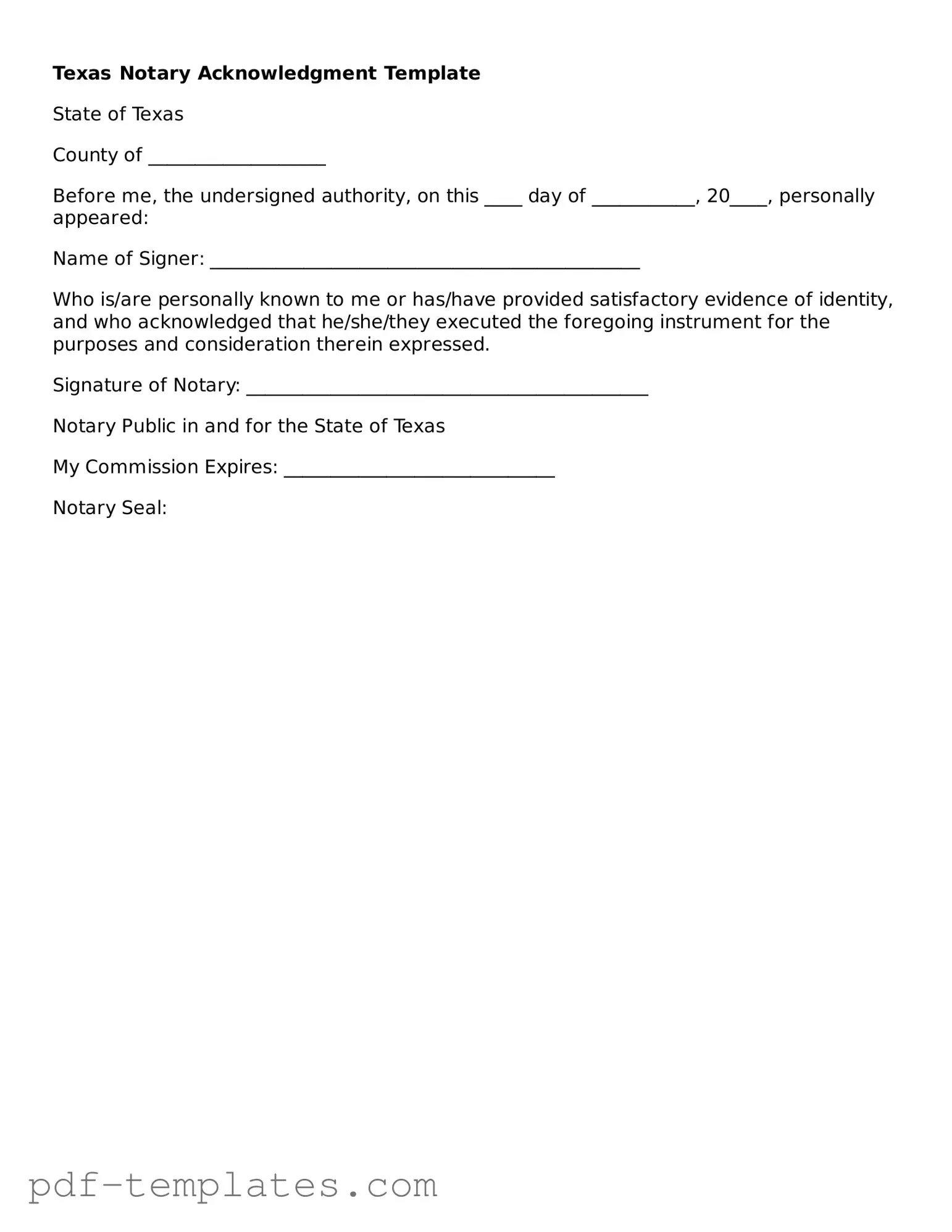The Texas Notary Acknowledgment form is similar to the Affidavit, which is a written statement confirmed by oath or affirmation. Both documents require a notary public to witness the signing and verify the identity of the signer. An affidavit serves as a declaration of facts, while the acknowledgment confirms that the signer willingly executed the document in front of the notary. The purpose of both documents is to ensure authenticity and provide legal backing to the statements made within them.
Another document comparable to the Texas Notary Acknowledgment is the Power of Attorney. This legal instrument allows one person to grant authority to another to act on their behalf. Like the acknowledgment form, the Power of Attorney requires notarization to validate the identity of the parties involved. Both documents serve to protect the interests of the parties and ensure that actions taken under their authority are legally binding.
The Deed is another document that shares similarities with the Texas Notary Acknowledgment. A deed is a legal document that transfers ownership of property from one party to another. Notarization is crucial for deeds, as it verifies that the grantor has signed the document willingly and is aware of the implications of the transfer. Both documents require the presence of a notary to ensure that the transaction is legitimate and enforceable.
Similarly, the Certificate of Acknowledgment is directly related to the Texas Notary Acknowledgment. This certificate is often attached to documents to confirm that the signer appeared before a notary and acknowledged their signature. Both serve the purpose of affirming the authenticity of the signing process, ensuring that the document can be relied upon in legal contexts.
In the realm of important legal documents, ensuring the authenticity of signatures and the identities of parties involved is crucial. For instance, when engaging in transactions that require tax exemptions, businesses must utilize forms like the California Resale Certificate, which allows for the purchase of goods without sales tax under specific conditions. This certificate plays a vital role in California's business landscape, akin to the importance of documents such as the Texas Notary Acknowledgement. For further reference, you can find All California Forms that may assist in understanding and accessing the necessary paperwork.
The Jurat is another document that bears resemblance to the Texas Notary Acknowledgment. A jurat is a certification that a signer has sworn to the truth of the contents of a document in front of a notary. While the acknowledgment focuses on the signature itself, the jurat emphasizes the truthfulness of the statements made. Both require notarization, reinforcing the legal validity of the documents.
In addition, the Will is a document that often requires a notary for validation, similar to the Texas Notary Acknowledgment. A will outlines an individual’s wishes regarding the distribution of their assets after death. Notarization helps to prevent disputes over the validity of the will by confirming that the testator signed the document voluntarily and with full understanding. Both documents aim to provide clarity and legal assurance regarding the intentions of the signers.
The Affidavit of Identity is another document that aligns with the Texas Notary Acknowledgment. This affidavit serves to verify the identity of an individual, often in situations where identification may be in question. Like the acknowledgment, it requires notarization to ensure that the individual presenting the affidavit is indeed who they claim to be. Both documents help to establish trust and credibility in legal matters.
The Loan Agreement is also similar to the Texas Notary Acknowledgment. This document outlines the terms of a loan between a lender and a borrower. Notarization of the loan agreement is often required to confirm that both parties have agreed to the terms and signed the document voluntarily. Both documents serve to protect the interests of the parties involved and provide a clear record of the agreement.
Lastly, the Real Estate Purchase Agreement shares characteristics with the Texas Notary Acknowledgment. This contract outlines the terms of a real estate transaction between a buyer and a seller. Notarization is essential to confirm that both parties have willingly entered into the agreement and that their signatures are authentic. Both documents play a crucial role in ensuring that real estate transactions are legally binding and enforceable.
